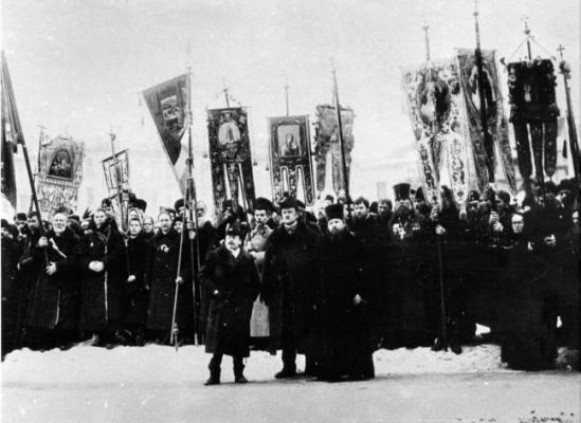Black Hundreds
Black Hundreds (Russian: черние сотни; chernye sotni). The popular designation for a number of Russian monarchist and chauvinist, ultranationalist organizations that appeared after the Revolution of 1905. The Union of the Russian People, led by the physician A. Dubrovin in Saint Petersburg, was the most important of these. The union was organized by reactionary landlords, bureaucrats, intellectuals, and clergy. A mass membership was recruited from the urban and rural population. The union was supported by the government and collaborated with the tsarist secret police, popularly known as the Okhrana.
According to their program, the Black Hundreds stood for autocracy, the concept of an all-Russian nationality (refusal to recognize Ukrainians and Belarusians as separate nations), and the indivisibility of the Russian Empire. They resisted democratic and social reform, constitutionalism, and the influence of non-Russian groups, particularly Jews (they were openly anti-Semitic), on society. They staged massive rallies, called ‘patriotic’ demonstrations, against liberal and progressive movements and even assassinated their opponents.
In Ukraine the Black Hundreds were well organized and found their support among Russified Ukrainians, particularly the nationally unconscious urban and rural elements and the pro-Russian Orthodox clergy (mainly in Volhynia). The following were the main centers of the movement: Odesa, where the local branch of the Union of the Russian People was headed by Count A. Kokovnitsyn, had a membership of 22,000, mostly of the urban population, in 1907, and published Za tsaria i rodinu; Kyiv, where M. Myshchenko was the leading activist; Kharkiv, where Kotov-Konoshenkov headed the local branch; Yelysavethrad, where I. Fomenko published the paper Glas naroda; and the Pochaiv Monastery in Volhynia, where Archimandrite V. Maksymenko directed the movement and the papers Volynskaia zemlia and Pochaevskii listok propagated its ideas. The Black Hundreds had their own battle groups (druzhiny), which in 1906–7 staged Jewish pogroms in Kyiv, Odesa, Yalta, etc. The Russian Assembly, although somewhat more moderate, was close to the Black Hundreds in outlook and spirit. It had branches in Kharkiv, Kyiv, and Odesa. Its Mirovoi trud was published in Kharkiv under the editorship of Prof A. Viazigin, the leader of the rightist faction in the Third State Duma. In 1906 the Odesa Union of Russian People was formed. It was headed by M. Rodzevich and had 10 branches in southern Ukraine.
At a congress in October 1906 in Kyiv the Black Hundreds set up a common front, called the United Russian People. In 1907–8 a similar front in Odesa, known as the Russian (White) Two-Headed Eagle, was headed by V. Belikovich. The Black Hundreds and other rightist organizations took advantage of the anti-Polish feeling among the peasantry of Right-Bank Ukraine in the election campaign to the Third State Duma (1907) and won all the seats for Kyiv gubernia and Volhynia gubernia. At the beginning of 1908 a group led by V. Purishkevich broke away from the Union of the Russian People and formed the Union of the Archangel Michael, with branches in Kyiv, Odesa (headed by B. Pelikan and publishing Iuzhnyi bagatyr), Kherson (organizer, I. Fomenko), and elsewhere. In 1910 another Black Hundred organization appeared in Odesa—the Southern Monarchist Union, led by Zaichenko. In 1913 the Black Hundreds, primarily members of the Union of the Archangel Michael, gained control of the municipal government in Odesa through fraudulent elections and closed down the Ukrainian Prosvita society there.
Using as an excuse the trial of M. Beilis, who was charged with the ritual murder of a Christian boy, the Black Hundreds organized an anti-Semitic campaign in 1913. Beilis's release by a Kyiv jury was a moral blow to the reactionaries (see Beilis affair). The Black Hundreds were still active during the First World War, but after the February Revolution of 1917 they dissolved or were formally abolished.
BIBLIOGRAPHY
Rukovodstvo chernosotentsa-monarkhista (Kremenchuk 1906)
Chernovskii, A. Soiuz russkogo naroda (Moscow-Leningrad 1929)
Zalezhskii, V. Monarkhisty, 2nd edn (Kharkiv 1930)
Vasyl Markus, Bohdan Struminsky
[This article originally appeared in the Encyclopedia of Ukraine, vol. 1 (1984).]

.jpg)